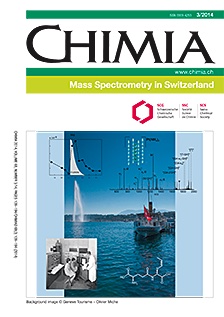Liquid Extraction Surface Analysis (LESA) of Hydrophobic TLC Plates Coupled to Chip-Based Nanoelectrospray High-resolution Mass Spectrometry
DOI:
https://doi.org/10.2533/chimia.2014.150Keywords:
Chip-based infusion, Lesa, Lipids, Liquid extraction surface analysis, Thin-layer chromatographyAbstract
Direct identification and structural characterization of analyte spots on TLC plates have always been of great interest and the development of interfaces that allow TLC to be combined with MS is making steady progress. The recently introduced liquid extraction surface analysis (LESA) approach has the potential to hyphenate TLC with MS. A mixture of lipid standards was separated on HPTLC RP-18 glass plates using chloroform:methanol :acetonitrile 2:1:1 (v:v:v) as mobile phase. After visualization with primuline dye (0.02% in acetone:water 8:2 (v:v)), LESA was performed, followed by a chip-based nanoflow infusion in combination with FTICRMS. The optimized extraction solvent composition was methanol:chloroform:water:formic acid 52:24:24:0.2 (v:v:v:v). A nanoelectrospray voltage of 1.6 kV and a gas pressure of 0.2 psi were applied in all experiments. All phospholipids were extracted successfully and detected unambiguously using the optimized TLC-LESA-FTICRMS procedure. Sampling the tricaprylin spot gave the most intense signals and also tricaprin was detected. Three other triacylglycerols of higher molecular mass have logP values between 15.5 and 21.6, which are the highest among all investigated compounds and are not detected from their corresponding spots, due to the fact that the solubility of very apolar lipids is not high enough in the extraction solvent. It was demonstrated that TLC can be elegantly combined with mass spectrometry based on the LESA approach. In general, apart from the analysis of lipids, TLC-LESA-MS has a high potential for medium-polar compounds separated on reversed-phase TLC plates, but limitations are present when very apolar compounds have to be extracted.Downloads
Published
2014-03-26
Issue
Section
Scientific Articles
License
Copyright (c) 2014 Swiss Chemical Society

This work is licensed under a Creative Commons Attribution-NonCommercial 4.0 International License.
How to Cite
[1]
M. Himmelsbach, E. Varesio, G. Hopfgartner, Chimia 2014, 68, 150, DOI: 10.2533/chimia.2014.150.







